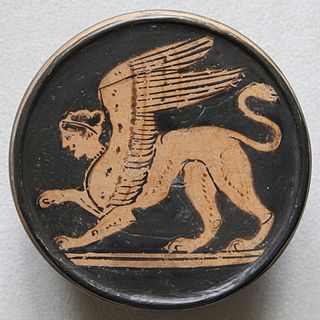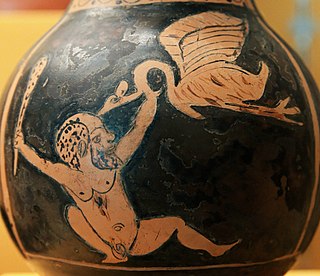
A centaur, occasionally hippocentaur, also called Ixionidae, is a creature from Greek mythology with the upper body of a human and the lower body and legs of a horse that was said to live in the mountains of Thessaly. In one version of the myth, the centaurs were named after Centaurus, and, through his brother Lapithes, were kin to the legendary tribe of the Lapiths.

The hippogriff or hippogryph, is a legendary creature with the front half of an eagle and the hind half of a horse.

A sphinx is a mythical creature with the head of a human, the body of a lion, and the wings of an eagle.

The Travels of Sir John Mandeville, commonly known as Mandeville's Travels, is a book written between 1357 and 1371 that purports to be the travel memoir of an Englishman named Sir John Mandeville across the Islamic world as far as India and China. The earliest-surviving text is in French, followed by translations into many other languages; the work acquired extraordinary popularity. Despite the extremely unreliable and often fantastical nature of the travels it describes, it was used as a work of reference: Christopher Columbus, for example, was heavily influenced by both this work and Marco Polo's earlier Travels.

The catoblepas is a legendary creature from Ethiopia (Africa), first described by Pliny the Elder and later by Claudius Aelianus.

A kinnara is a creature from Hindu and Buddhist mythology. They are described as part human and part bird, and have a strong association with music and love. Believed to come from the Himalayas, they often watch over the well-being of humans in times of trouble or danger. An ancient Indian string instrument is known as the Kinnari vina. Their character is also clarified in the Adi Parva of the Mahabharata, where they say:
We are everlasting lover and beloved. We never separate. We are eternally husband and wife; never do we become mother and father. No offspring is seen in our lap. We are lover and beloved ever-embracing. In between us we do not permit any third creature demanding affection. Our life is a life of perpetual pleasures.

In the Dungeons & Dragons fantasy role-playing game, the centaur is a large monstrous humanoid. Based upon the centaurs of Greek myth, a centaur in the game resembles a human with the lower body of a horse.

The Pygmies were a tribe of diminutive humans in Greek mythology.

The griffin, griffon, or gryphon is a legendary creature with the body, tail, and back legs of a lion, and the head and wings of an eagle with its talons on the front legs.

The Centaurides or centauresses are female centaurs. First encountered in Greek mythology as members of the tribe of the Centauroi, the Centaurides are only occasionally mentioned in written sources, but appear frequently in Greek art and Roman mosaics. The centauress who appears most frequently in literature is Hylonome, wife of the centaur Cyllarus.

In late Classical Greek art, ichthyocentaurs were centaurine sea beings with the upper body of a human, the lower anterior half and fore-legs of a horse, and the tailed half of a fish. The earliest example dates to the 2nd century B. C., among the friezes in the Pergamon Altar. There are further examples of Aphros and/or Bythos, the personifications of foam and abyss, respectively, depicted as ichthyocentaurs in mosaics and sculptures.
Hippopodes, meaning "horse-footed," is an allegorical creature in Greek mythology that is often associated with greed. According to the myth, the Hippopodes were a tribe of beings with the lower bodies of horses and the upper bodies of men. They were said to have guarded a fabulous treasure, but their insatiable greed made them unwilling to share it with anyone. This greed ultimately led to their downfall. The allegory of the Hippopodes serves as a cautionary tale against the dangers of greed and avarice.

Various species of mythical headless men were rumoured, in antiquity and later, to inhabit remote parts of the world. They are variously known as akephaloi or Blemmyes and described as lacking a head, with their facial features on their chest. These were at first described as inhabitants of ancient Libya or the Nile system (Aethiopia). Later traditions confined their habitat to a particular island in the Brisone River, or shifted it to India.

A legendary creature is a type of fantasy entity, typically a hybrid, that has not been proven and that is described in folklore, but may be featured in historical accounts before modernity.
Centaurs appear often in popular culture. Some appearances are also listed under Centaurides.
Magical creatures are an important aspect of the fictional world of Narnia contained within The Chronicles of Narnia book series and connected media originally created by C. S. Lewis. Throughout the seven books of the series, the protagonists encounter a variety of these creatures as they travel throughout Narnia and the surrounding lands and seas, including Archenland, Calormen, and the Great Eastern Ocean.












